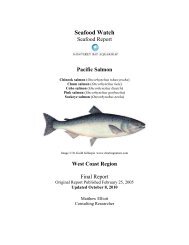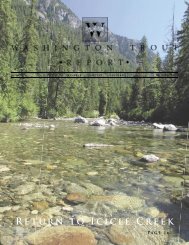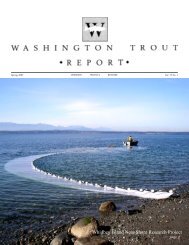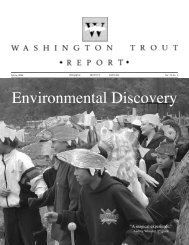Skykomish Draft Final Report - Wild Fish Conservancy
Skykomish Draft Final Report - Wild Fish Conservancy
Skykomish Draft Final Report - Wild Fish Conservancy
You also want an ePaper? Increase the reach of your titles
YUMPU automatically turns print PDFs into web optimized ePapers that Google loves.
Introduction<br />
Snohomish County Surface Water Management and partners have proposed to identify and<br />
prioritize opportunities to restore reach-level channel processes within the braided section of the<br />
<strong>Skykomish</strong> River extending from the cities of Gold Bar to Sultan, WA. The braided reach<br />
(“study reach”) includes over ten miles of mainstem channel between “Big Eddy” in Gold Bar<br />
(rm 43.3) and Sultan (rm 33), and nearly seven miles of interconnected side channels (Figs 1–7).<br />
In 2004 Washington Trout (WT) surveyed the braided reach in support of the following project<br />
goals:<br />
• to describe patterns of current fish use within the study reach to define a baseline against<br />
which future conditions can be compared;<br />
• to identify critical fish habitats so that restoration actions with high likelihood of creating<br />
and maintaining these habitats can be prioritized;<br />
• to evaluate the biological cost and benefit of proposed restoration actions.<br />
Washington Trout’s 2004 field work served two general tasks designed to evaluate fish use<br />
within the braided reach. First, fish species composition and relative abundance were surveyed<br />
seasonally within a subsample of habitat units chosen to represent the overall habitat-type<br />
distribution in the study reach. The specific objectives of these surveys were (i) to compare<br />
species diversity and relative density of adult and juvenile fishes in the study reach’s mainstem<br />
and in associated side channel networks; (ii) to identify physical habitat features significantly<br />
related to fish relative density, including habitat unit type and size, and within-unit survey<br />
location (e.g. channel center versus edge habitat; unit middle versus upstream–downstream unit<br />
interface; Fig. 8); and (iii) to examine seasonal and diel variation in species composition,<br />
distribution, and relative abundance.<br />
The second task related to fish-use assessment was characterization of salmon spawning activity<br />
in the study reach. Redd and carcass surveys were performed in order to (i) quantify the<br />
incidence and timing of spawning activity throughout the braided reach; (ii) to document<br />
species-specific patterns in the spatial distribution of spawning; and (iii) to examine the<br />
relationship between spawning activity and physical habitat characteristics.<br />
Patterns of fish use in the <strong>Skykomish</strong> River braided reach provided guidance for developing both<br />
a general strategy and specific projects for restoring and protecting habitat. Recommendations<br />
for designing and prioritizing such projects are presented in Chapter X.<br />
Methods<br />
Reach Nomenclature<br />
The braided reach was partitioned into distinct habitat units (pools, riffles, glides) according to<br />
the Snohomish County Preliminary Habitat Analysis of July 2004 (Figs 1–7). To facilitate<br />
comparison among units, unique identifier numbers were assigned to each mainstem and side<br />
channel habitat unit surveyed. Side channel networks were named from upstream to downstream<br />
as follows: SCA (right-bank channel near the city of Gold Bar) (Fig. 3), SCB (left-bank network<br />
near Gold Bar) (Fig. 3), SCC (left-bank network between the cities of Startup and Sultan) (Figs<br />
5, 7), SCD (right-bank network near Sultan) (Fig. 6).<br />
Preliminary habitat-type designations, based on inspection of channel morphology in aerial<br />
photographs taken during summer low-flow conditions, were ground-truthed by Washington<br />
1






